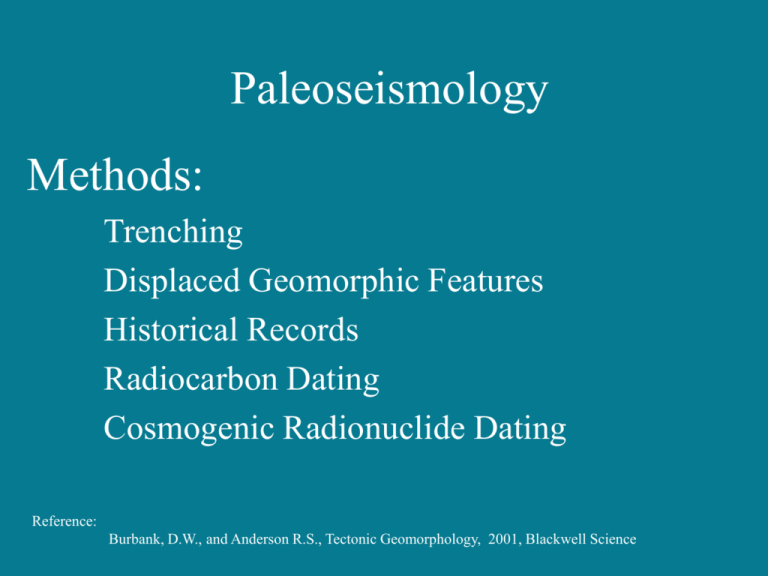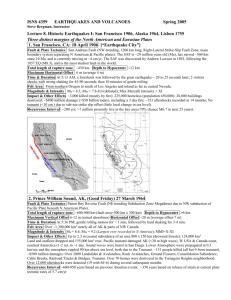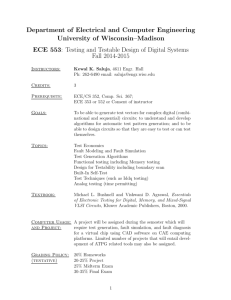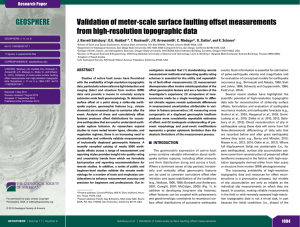Paleoseismology
advertisement

Paleoseismology Methods: Trenching Displaced Geomorphic Features Historical Records Radiocarbon Dating Cosmogenic Radionuclide Dating Reference: Burbank, D.W., and Anderson R.S., Tectonic Geomorphology, 2001, Blackwell Science Trenching • Practical Objectives: – Identify and date layers within a stratigraphic succession that contain information about the faulting history – Document the amount of displacement from faulting activity Trenching Trenches should contain: • abundant datable material • provide structural and stratigraphic markers • preferentially thinly bedded deposits - better at illustrating discrete measurable offset - relic shorelines - small scale channels Trench orientation/scale: Salt Creek Trench • 1 perpendicular to fault trace • 2 parallel to fault trace, located on either side of trace • depth of the trench should be appropriate for scale of fault • length of the trench should be long enough to cover the deformation zone Trenching Once the trench has been excavated: • stratigraphic horizons are meticulously mapped • material for dating various horizons is removed Fault displacement history constructed Stratigraphic and structural relationships: a) increasing offset with depth, growth on the fault b) incomplete erosion can give the appearance deformation from topography of underlying surface c) erosion of the upthrown block can create colluvial wedge d) fissures opening along fault trace fill with colluvial material e) injection dikes in subsurface, sand volcanoes provide evidence of past earthquakes f) Liquefaction can cause folding of surface sediments - lower limit on age of earthquake The trench support structure and some sediment packages The edge of a channel and corresponding channel fill Offset bedding: characteristic of fault deformation Desiccation cracks in cross section, indicative of a dry lake bed Displaced Geomorphic Features Geomorphic features that can be offset: • rivers, streams, channels, terraces • debris flows & raised levees • alluvial fans • ridges & gullies • beach ridges, coral platforms, delta plains, wave cut notches • Anthropogenic features: • roads, orchards, fences, telephone poles, drainage channels, etc Anything that has an easily identifiable shape/outline that can be offset A key feature to identify is the piercing point - unique rock types that formerly extended across the fault and can be used to determine displacement. Displaced Geomorphic Features Landforms can be altered over time through erosional processes and may not directly intersect the fault plane, but detailed topographic and geologic mapping can reveal these relationships horizontal offset: once fault plane is specified, linear features are projected onto fault plane and the offset measured vertical offset: subhorizontal features (e.g. channel bottoms) are projected onto the fault plane and the offset is measured Displaced Geomorphic Features Offset features can illustrate both the processes that initially displaced them and also processes that can modify them Fluvial incision/erosion creates: • channel walls, terraces, gullies Aggradational/depositional phases leave: • broad wide alluviated surfaces with few distinctive features • can bury previously existing features obscuring previously recorded seismic events. Earthquakes occurring during incision events are better preserved in the geomorphic record. Historical Records • Records from towns/cities near fault zones locally Missions have good records. • Travelers/settlers journals, observations they made of the landscape and perhaps events. • Less exact but still useful are myths and legends of local cultures. Radiocarbon Dating The most commonly used dating method to date geomorphic features 14C is formed in the atmosphere through the interaction of cosmic radiation and nitrogen, and every living thing exchanges 12C and 14C throughout their life. 1n + 14N --> 14C + 1p Once the organism dies this exchange stops and the 14C decays 14C -->14N + b It’s half life is 5730 yrs, and present instrumentation can give ages back to between 58-62 kyrs Cosmogenic Radionuclide Dating In the last few decades we have been able to date the exposure time of surfaces through the exposure to cosmic radiation. Characteristics of Cosmic radiation: • charged particles are directed into Earths atmosphere by the magnetic field • stronger beam of particles at higher latitudes • atmospheric attenuation reduces the atmospheric production of radionuclides with a 1/e length scale of roughly 1.5 km within the lower atmosphere • cosmic radiation impacting the surface produce cosmogenic radionuclides (CRN), decaying with a 1/e scale of 60-70 cm Corrections need to be made for latitude and longitude, because of differential exposure rates Commonly used CRN and their production rates (atoms/gram of quartz/year at sea level): 14C - 21.0, (1/2 life 5730 yrs) 10Be - 5.81, (1/2 life 1.5 million yrs) 26Al - 34.9, (1/2 life 720 kyrs) 36Cl - 4 - 9, (1/2 life 308 kyrs) Cosmogenic Radionuclide Dating CRN’s have been used in two distinct settings: — Bare Bedrock — Depositional Surfaces to identify either exposure rate and/or erosion rate of that surface. The concentration in a rock parcel is determined by: dN/dt = P - lN N = # of CRN’s per unit volume rock t = time P = production time l = decay constant The complexity of this method lies in the history of the production rate. Depositional surfaces have a significant problem in that they likely consist of material that has an “inheritance”, i.e. prior exposure e.g. Fluvial terrace inheritance derived from: • exhumation through the CRN production boundary layer as hill slope is lowered • transport within the hill slope or fluvial system • final deposition and exposure Cosmogenic Radionuclide Dating This is the 10Be record from Lake Bonneville Samples taken from a sand bar that is associated with the last lake highstand at 14.5 ka. The grey area is the inherited age from prior exposure of the quartz grains. If the age line had not been shifted to account for inheritance the age would have been calculated at ~26 ka, 11 ka too old. One way to limit the effect of inheritance: • collect samples from a range of depths • > 2 m age due entirely from inheritance









